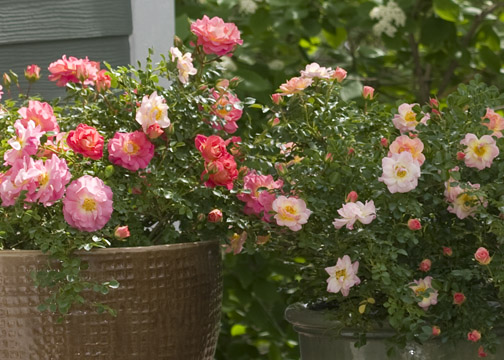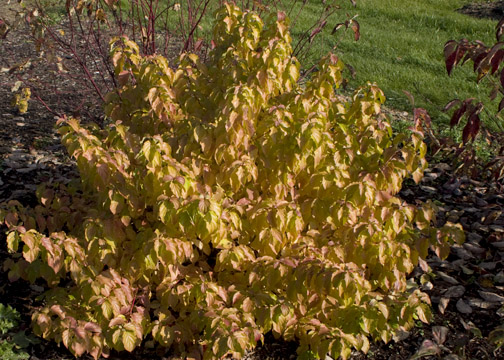For those of you that use a Blackberry, IPhone or an Android, I’ve created simple mobile blog. It’s a lot easier to read. The easiest way to access it is to use your QR reader to snap a picture of the QR Code above. If you don't have a QR reader search your apps for a reader and download it. These little codes are real handy for Smart Phone users. We're even going to add them to our Proven Winners ColorChoice tags to give shoppers even more information. Let me know how it works for you.
Good Gardens start with Foliage, not Flowers
It’s easy to find new plants. What’s hard is finding better plants. When I hunt for new plants it’s easy to get overly excited. I have to show some discipline, otherwise, I’ll end up with lots of plants that are interesting for collectors, but useless for gardeners.
 |
| Good gardens should based on form and foliage, and not just flowers. |
Some years back I heard J. C. Raulston lamenting that no one wanted to grow all the cool plants he collected and distributed. He examined the problem and then developed a list attributes that he felt made a plant a successful. This prompted me to develop my own list. My list gives me the discipline I spoke of earlier. I also use it shape and guide our Proven Winners shrub program. The vision I have for this program goes beyond novelty or new. My goal is to reinvent flowering shrubs; to change the way people perceive and use flowering shrubs; to make them more useful. My plant selection criterion helps to keep this vision on track. So my next few posts will examine some of the attributes I consider important when hunting out new selections. Today we’ll examine the importance of foliage.
Plants with Attractive Foliage
 |
| Spilled Wine Weigela has black leaves with ruffled margins |
Shrubs and perennials typically flower for three to six weeks. Sure there are exceptions, but flowers are fleeting and foliage is not. A lesson I learned when grew and sold perennials is that they sell great when they’re in bloom. But after they’ve finished flowering - no one wants to buy them. This was not the case for perennials with interesting foliage. I could sell Hosta, Heuchera, Artemesia, Festuca, Japanese Ferms (Athyrium nipponicum 'Pictum) and Variegated Iris (Iris pallida 'Variegata') all season long.
As a landscape designer I learned that the most interesting gardens were those based on form and foliage, and not the flowers. Flowers should be considered as icing on the cake, not the cake itself. Attractive foliage, be it colorful, variegated, textured, fall color, or glossy can make a garden attractive even when it’s not in bloom. These plants are good for the garden centers because they extend the selling season. And they’re good for gardeners and landscapers because they make for interesting gardens.
This is a powerful, yet largely untapped, goal for plant breeders. Consider daylilies (Hemerocallis), which has more plant breeding activity than any other species. Sure it’s a glorious plant in bloom, but when the flowers are spent it is one of the saddest of all plants. At one point in my life I managed a daylily collection that contained over 500 cultivars; many of them award winners. Once the flowers were gone the collection was an ugly mess. But if you looked closely, you would discover that, while most of the plants turned yellow and collapsed to the ground, a few stood tall and remained deep green. Look even closer and you would find a few plants with bluish leaves or glossy foliage. So why can’t these plants have better foliage?
 |
| Lil' Miss Sunshine Caryopteris is colorful all season long |
Clearly, foliage alone will never be as sexy as a flower, but can’t we have both? I think we can. Here is just a small sampling of shrubs that give you both the icing and the cake.
 |
| Black Lace Elderberry has black, lacy leaves and big flowers. |
 |
| Variegated Plants like My Monet Weigela provide long lasting color. |
 |
| Glossy foliage was a selection criteria for Oso Easy Roses. |
 |
| Fall Foliage is a bonus. Arctic Sun dogwood has peach autumn hues. |
 |
| Spring color can be as good as fall color, as on Spirea Double Play Big Bang |
Fred Case: Outstanding Teacher
Fred Case once told me he choose to be a High School teacher instead of a college professor because it afforded him more time to be out in the field studying plants. He could have been a great college professor, but instead he became an outstanding high school teacher. You have to be an outstanding teacher to win The Outstanding Teacher Award and Fred was honored twice. He was named Outstanding Biology Teacher in 1971 and Outstanding Science Teacher in 1987. Fred Case was not your typical high school teacher.
 |
| Fred Case in his garden |
I was never a student at Arthur Hill High School in Saginaw Michigan, however, I was fortunate enough to be his pupil for two lectures at Michigan State. I consider myself lucky to have known Fred and to have been his student, even if it was just for two days. His passion for plants and nature was contagious. He left me with an overpowering desire to be out in the woods studying plants. He did much more than teach, he inspired. Fred Case, teacher and botanist passed away Wednesday, January 12, 2011 at the age of 83 years.
Fred was an internationally acclaimed expert on North American native orchids, trillium and insectivorous plants. He and his wife Roberta authored three books and authored or co-authored many articles for magazines and scientific publications about native orchids, trilliums, insectivorous plants, wildflowers and gardening. He received numerous awards and recognition for his achievements in botany and lectured extensively. He had been associated with Cranbrook Institute of Science, The University of Michigan Matthaei Botanical Gardens, Longwood Gardens, The Michigan Dept. of Natural Resources Committee on Endangered and Threatened Plants, the Michigan Botanical Club, North American Rock Garden Society, the Saginaw Valley Audubon Society, Saginaw Valley Orchid Society and The Nature Conservancy. In short, he was he was an icon in the field of botany.
 |
| Trillium cuneatum the Whippoorwill Flower |
Fred was good enough to trust me to introduce one of his most beautiful plant discoveries. Berry Heavy Gold® (Ilex verticillata 'Roberta Case'). Commonly known as Michigan holly or winterberry, Fred's selection has the brightest and largest berries of all the gold selections introduced. Older selections such as Winter Gold are really more orange than gold, but Berry Heavy Gold is the real deal. It shines in the garden. Heavy fruiting, this native deciduous holly is great for mass plantings, providing winter interest, especially when mixed in with red fruited varieties such as Berry Heavy Red. I love that this outstanding landscape plant is a living legacy to this great plantsman.
 |
| Berry Heavy Gold® Ilex verticillata |
 |
| Berry Heavy Gold® Ilex verticillata in the snow |
The last time I saw Fred, I was on my way home from a weekend of steelhead fishing on the Au Sable river. The trillium were in full glory that perfect spring day. A camera crew from Martha Steward Living had been scheduled to photograph his Trillium collection but the deal fell through, so I had the teacher to myself. He showed me every plant in his garden, chiming "This one's a really good garden plant," or "Your nursery should offer this Viburnum." And then it was time to rest. We sat down on the veranda for iced tea and warm conversation. There was no more talk of plants, but rather friends and family; the important things in life.
Schizophragma Climbs in Popularity
Schizophragma hydrangeoides, while called the Japanese Hydrangea-vine, is not actually a hydrangea. It is, however, in the Hydrangea family. At first glance, at a distance or when out flower, it can look very much like Hydrangea anomala petiolaris the Climbing Hydrangea. But upon closer inspection the two are easy to distinguished because true Hydrangea has 4 petals (actually sepals) while Schizophragma has one solitary heart-shaped sepal. Another useful clue is that Schizophragma hugs a tree or wall more closely than does Climbing Hydrangea. Both are beautiful vines to be sure, but if I had to choose between the two I would choose Schizophragma because the flowers are showier and there are more cultivars to choose from.
 |
| An elegant vine when grown on brick |
 |
| This vine is a tower of white when grown on a large tree |
The blooms range from 8 to 10 inches in diameter. They appear in late June to early-July and last for around four weeks.
 |
| Schizophragma has showy pure white blooms with tear-drop sepals |
The cultivar 'Moonlight has the added bonus of attractive, colorful foliage. The leaves are steel-blue with contrasting green veins. The sepals are typically larger and showier. This is perhaps the most popular cultivar.
 |
| 'Moonlight' has showy steel-blue leaves |
The cultivar 'Rosea' is, as the name indicates, pink. The sepal color can vary from year to year based on the weather. It can range from pure white to a rich pink. Every years is a surprise! The sepal size is larger than typical and can be quite showy.
 |
| The cultivar 'Rosea' has pink sepals |
The cultivar 'Strawberry leaf has distinct foliage with deeply toothed leaf margins. The sepals are pure white and typical in size.
 |
| 'Straberryleaf' has a distinctive dentate leaf margin. |
There are two variegated selections, however, I don't think they are yet available in the United States. I found the gold variegated form at Liss Forest Nursery in England and a Silver form at a small nursery in Japan. Both plants add extra color after the flowers have faded.
 |
| Liss Forest Gold |
 |
| A silver variegated form |
Windmills-TM is a new selection of Schizophragma integrifolium commonly called the Chinese Hydrangea vine. It has long narrow, pure white sepals. It is rated as a zone 7 plant so it is best reserved for milder climates. I selected this plant out of a batch of seedlings and have been evaluating it over the last 10 years. The extra large flowers are both remarkable and elegant.
 |
| Windmills is a new selection of Schizophragma integrifolium |
Schizophragma is gaining in popularity, however, it is not easily found at your local garden center. If you want to try this vine you will most likely have to buy it via mail-order or over the internet. I really like this vine and I think you will too.
Subscribe to:
Posts (Atom)


